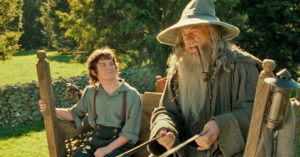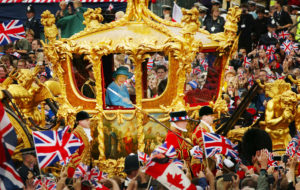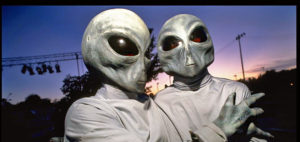Once upon a time, a teenager called Sarah was looking for a Father’s Day present for her dad, Jim. For hours she scoured the bazaars of St Albans, but none had quite what she wanted. The sunshine began to fade, and it seemed she would end her search empty-handed. But then, as dusk was falling, she found herself outside the window of the very last shop. The sign above the door read “Simmons Bakers”.
A name from the pages of legend: one of the finest independent bakers in all Hertfordshire! Surely, surely…
And it was then, peering through the glass, that she saw it. A squat golden figure, grinning and goggle-eyed. There could be no mistake: here was E.T., the Extra-Terrestrial, made entirely of marzipan.
Sarah knew at once that this was a gift from the gods. Only a few weeks before her father had taken her younger sister, Mary, to see E.T. at the cinema. Both had wept buckets. What was more, her father adored marzipan. She looked for a price tag. One pound seventy-five. Bargain!
If you’re wondering how I know all this, the answer lies in an online report on the BBC’s “Beds, Herts and Bucks” news page a few weeks ago, though I may have added a little fairy-tale stardust of my own. The marzipan E.T. figure still exists, which is why it made the news. As Jim’s daughter Mary explained, she found it after his death last year, perfectly preserved. A miracle? Well, not quite. Her father might have loved marzipan, Mary said, but he had enjoyed E.T. so much that he never wanted to eat it. “I am now its keeper,” she added, “and I’ll never eat it either.”
For those of us of a certain age, the only thing more terrifying than the prospect of eating 40-year-old marzipan is the realisation that fully four decades have elapsed since Steven Spielberg’s E.T. ruled the box office. I was almost eight when my parents took me to see it. I well remember my fascination with the basic premise — dwarfish alien botanist, disastrously stranded in the cultural desert of suburban California, is desperate to find his way home — and can even more vividly recall my utter desolation when it seemed the ugly little fellow’s race was run. And I’m happy to report that Spielberg’s film has lost none of its power. We watched it with my son during one of the lockdowns, and my wife’s decision to invest in a huge packet of tissues was richly vindicated. (He cried too, but not as much as me.)
The story behind E.T. is well known, and has never better been told than in the review by Time’s critic, Richard Corliss, a few days before the film’s release in June 1982:
Once upon a time there was a little boy named Steven, who lived in a mythical land called Suburbia. His house was just like everybody else’s house; his family’s car and dog and swimming pool were just like everybody else’s too. But little Steven’s dreams were different. He dreamed of telling the stories of his strange land — wonderful tales of his home and his school, his parents and especially his friends — and making them shine like new. So every night he would tiptoe outside his ranch-style house and make a wish on the brightest star in the suburban sky. Over and over he would whisper, “Help me tell the story …”
E.T. is a fairy-tale about growing up in suburbia and dreaming of the world beyond. It’s a film about feeling different and struggling to fit in, about the outsider hiding within us all. It’s also, very famously, a film about a child — the hero, Eliott — wounded by his parents’ divorce. Spielberg had been deeply hurt by his own parents’ separation in the early Sixties, and had actually been working on a fictionalised version of their story before he turned to E.T.. And even now, 40 years on, it remains a sublimely affecting account of what family trauma does to an impressionable child — all the more so because it is, of course, a child’s escapist fantasy.
But E.T. is also very obviously a film of a particular era. The late Seventies and early Eighties are much in vogue at the moment. ABBA — peak years 1976 to 1981 — have retaken the stage to rapturous applause, albeit in digital avatar form. Star Wars’s Obi-Wan Kenobi, created by Spielberg’s close friend George Lucas in 1977, now has a Disney series of his own. A fourth Indiana Jones film, continuing the story Spielberg and Lucas began in 1981, is out next year. Even Tom Cruise’s Top Gun: Maverick, which currently dominates the box office, tries to recapture the spirit of the mid-Eighties, Ronald Reagan’s shiny, swaggering, shoulder-padded heyday, when it was forever morning again in America.
There’s an obvious generational explanation for all this. If, like me, you remember sobbing at the cinema as E.T. lay dying, then you’re probably in your late forties or early fifties, easy prey for the nostalgia industry. Life is more complicated than it used to be: more hectic, more stressful, more fraught with compromise and disappointment. As the accountants at Disney’s streaming service know only too well, it’s natural to yearn for the simplicity and innocence of childhood. When you watch E.T. now and feel the tears pricking at your eyeballs, are you crying for the alien, or for Elliott — or for yourself?
Were the late Seventies and early Eighties really a more innocent time, though? No, of course not. Flick through the pages of any newspaper and you see stories just as heart-breaking and hair-raising as any you’d find today: revolution and war in the Middle East, bloody repression in Poland, a child-abuse panic in America, terrorist atrocities in Northern Ireland. For Spielberg’s generation, the scars of Watergate and Vietnam were still painfully raw – as were memories of the Holocaust, which his Orthodox Jewish parents had often discussed with him when he was growing up. “I was a scared kid,” he told an interviewer from Rolling Stone in 2007. “I was born a nervous wreck, and I think movies were one way of transferring my own private horrors to everyone else’s lives.”
But there was a palpable difference between then and now, and you need only rewatch a film like E.T. or the original Star Wars to see it. For all Spielberg’s talk about private horrors, both films are fundamentally, unselfconsciously optimistic. People are decent, Han Solo has a heart of gold, and tomorrow really will be brighter than today. In E.T., for example, much of the tension surrounds a shadowy group of government agents who are determined to capture the alien for themselves. At first glance it seems all very Watergate, echoing Seventies conspiracy thrillers like The Conversation or The Parallax View. But it turns out that their leader, “Keys”, is actually a thoroughly decent fellow, a grown-up version of young Elliott himself. Official America, in other words, isn’t so bad after all. “I’ve been wishing for this,” Keys says at one point, “since I was 10 years old.” It’s hard to imagine a US government agent in 2022 being given a line like that.
Both films also share a fundamental faith in modernity itself: in science, technology and the idea of the future. In Star Wars, it’s true that the ships and uniforms are battered and grubby, reflecting a sense of decline since the Empire replaced the Republic — a very Roman theme. But none of the characters ever doubts that technology is good for them. There are no environmental costs; you can fire up your speeder as often as you like without worrying about climate change. Nor does anybody really question their society’s reliance on walking artificial intelligence, except for the barman at the Mos Eisley cantina (“We don’t serve their kind here”). Like E.T.’s alien plant-enthusiast, droids are useful, good-natured, even kind-hearted. They’re not trying to take over the world. They’re just trying to help.
If you want an insight into the mentality behind films like E.T., perhaps the best place to go is the Nasa visitor centre at Cape Canaveral, a vast monument to the optimism of a vanished age. The entire experience is infused with a sense of faith: in America, in technology, in progress, in humanity itself. On the screens above you, a succession of elderly men and women with reassuring Midwestern accents talk of comradeship and teamwork, duty and commitment. None of them questions whether it was worth it, or doubts that they were doing the right thing. And the entire experience is underpinned by a sense of narrative, a story driving towards a moment of apotheosis. That moment, of course, is 20 July 1969, when Neil Armstrong stepped onto the moon. “The first thing I think about when I think about the Sixties,’” Spielberg told Rolling Stone, “is when we landed on the moon.”
But my overwhelming impression after visiting Nasa a few months ago, rather like my feeling after rewatching E.T., was simply one of nostalgia. Armstrong’s giant leap for mankind was more than a half a century ago; for children today, it is as remote as the Battle of the Somme was to children in 1969. To put it bluntly, the moment has passed. The Space Race is over. Nasa’s government funding has dried up; it relies heavily on private sponsorship now. When we think of technology today, we often think of the costs, not the benefits. Despite the miracle of the Covid vaccines, a believer in scientific progress today runs a gauntlet of cynicism and disillusionment. And who now believes in the future?
So if there was a film in the summer of 1982 that foreshadowed our present, it wasn’t E.T.. It was a competitor released just two weeks later, which performed very poorly at the box-office but became one of the most aesthetically influential science-fiction visions ever made. With its neon cities shrouded in smog and pollution, its streets crowded with rogues, immigrants, whores and replicants, its nightmarish future of driving rain and endless night, Ridley Scott’s Blade Runner could hardly feel more different from the moral universe of Spielberg’s fairy-tale. But today our world seems closer to Scott’s vision than to Spielberg’s. And perhaps that’s why E.T. still commands such power, as a reminder of what we’ve lost.
All of which, of course, brings us back to that marzipan. As Jim Robson’s daughter Mary told the BBC, they would get it out now and again in the intervening years, to remind them of days gone by. “It was nice to see it again, it’s like a familiar face, so finding it wasn’t sad because it just always made us laugh,” she said wistfully. “I took it home to look after and I haven’t put it away. I like to see it every day.”
A bittersweet story, then. But perhaps the last word should go to St Albans’s equivalent of the engineers behind the Apollo missions, the director of Simmons Bakers. He was pleased to hear that their creation had lasted forty years, he said. “But I still wouldn’t recommend eating it.”
Disclaimer
Some of the posts we share are controversial and we do not necessarily agree with them in the whole extend. Sometimes we agree with the content or part of it but we do not agree with the narration or language. Nevertheless we find them somehow interesting, valuable and/or informative or we share them, because we strongly believe in freedom of speech, free press and journalism. We strongly encourage you to have a critical approach to all the content, do your own research and analysis to build your own opinion.
We would be glad to have your feedback.
Source: UnHerd Read the original article here: https://unherd.com





